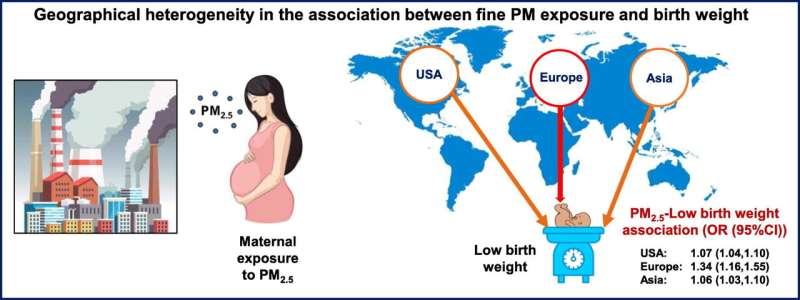This article has been reviewed according to Science X's editorial process and policies. Editors have highlighted the following attributes while ensuring the content's credibility:
fact-checked
peer-reviewed publication
trusted source
proofread
Air pollution during pregnancy linked to low birth weight, study finds

A recent study has uncovered a troubling link between exposure to PM2.5 air pollution during pregnancy and the risk of low birth weight in newborns. This study highlights the significant impact of air quality on prenatal development and emphasizes the urgent need for stricter air pollution controls. The research team includes Hebrew University's School of Public Health and Hadassah Medical Center.
The study is published in the journal Science of The Total Environment.
The study, led by Dr. Wiessam Abu-Ahmad and Professor Hagai Levine, in collaboration with Prof. Ronit Nierl, analyzed data from a comprehensive systematic review and meta-analysis encompassing 84 studies worldwide, representing about 42 million births. The findings draw attention to the pronounced health risks associated with the fine particulate matter commonly emitted from transportation and industry.
Dr. Abu-Ahmed pointed out, "Our analysis reveals stark regional variations in the impacts of air pollution on fetal development. This underscores the need for a localized approach in monitoring and mitigating air pollution. Particularly concerning are the strong correlations found in European studies, likely influenced by specific environmental and climatic conditions."
The research indicates a positive relation between high levels of PM2.5 particles during pregnancy and an increased likelihood of babies being born at low birth weights. Low birth weight is a critical concern as it is linked to numerous health complications later in life, including heart disease, diabetes, and developmental issues.
The researchers stress the urgency of establishing an updated national database to monitor the effects of air pollution effectively in Israel. "The discrepancies among global studies highlight the complexities of environmental health risks and the critical need for targeted research and policies," explained Prof. Levine.
This study forms part of a broader research initiative focusing on environmental exposures and fetal growth. The insights from this study are pivotal in reinforcing the battle against air pollution and safeguarding public health, particularly for infants and pregnant women.
The study's implications point to the necessity of reevaluating public health policies to prioritize the well-being of the most vulnerable populations, particularly pregnant women, and children.
Prof. Levine further emphasized the societal responsibility to adapt healthier and more environmentally friendly practices, "It is imperative that both personal and governmental actions are intensified to address this health hazard. Effective measures, including stricter regulations to reduce emission sources, applying 'polluter-pays' principle and political commitment are essential to safeguard public health of the current and future generations."
More information: Wiessam Abu Ahmad et al, Meta-analysis of fine particulate matter exposure during pregnancy and birth weight: Exploring sources of heterogeneity, Science of The Total Environment (2024). DOI: 10.1016/j.scitotenv.2024.173205





















